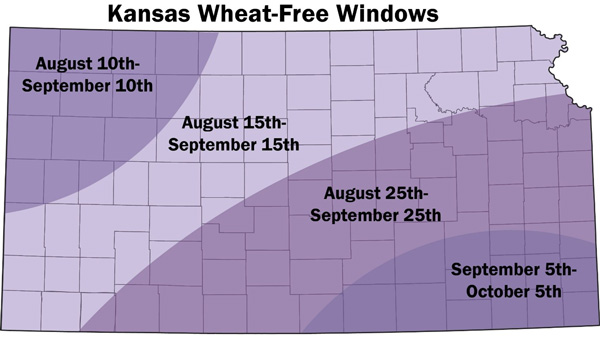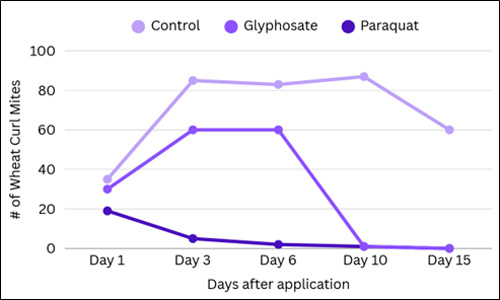This article is the first in a multi-week Agronomy eUpdate series on wheat streak mosaic complex management to address the 2025 outbreak.
Wheat streak mosaic complex (Figure 1) devastated many wheat fields across central and western Kansas in 2025. The conditions that favored this outbreak were covered in this previous eUpdate article: eupdate.agronomy.ksu.edu/article/high-levels-of-wheat-streak-mosaic-virus-in-parts-of-kansas-in-2025-640-8.
Wheat streak mosaic complex consists of a complex of three viruses: wheat streak mosaic virus, Triticum mosaic virus, and High Plains wheat mosaic virus. When two or more of these viruses are present in the same field, yield losses can be synergistic. As a reminder, the wheat streak mosaic complex of viruses is vectored by the tiny wheat curl mite (Aceira tosichella). We know that mite populations were very high in the state at the end of the 2025 season. Research has reported that up to 500 curl mites can be found on a single healthy wheat head, which can conservatively translate to more than 1 billion mites per acre.
Curl mites can only survive ~4 days without a living host, so when the wheat crop dries down, mites will work their way to the top of plants and assume an “upright posture” to help them disperse by wind. Curl mites don’t fly, and they walk very slowly, so dispersal by wind is their only way to move in the landscape. The period when mites are migrating off the mature wheat crop has been referred to as the “mite rain” period, as billions of mites are showering down in the landscape. When conditions are very windy, mites can be passively dispersed more than 10 miles. The highest risk place for curl mites to survive the summer is volunteer wheat that is present at or around harvest.
Conditions that favor grain shattering, such as preharvest hail or harvest delays due to windy storms (such as much of the 2025 Kansas wheat harvest), can increase the presence of pre-harvest volunteers. If mites are allowed to survive on this volunteer wheat or alternative hosts until the fall-established wheat crop is planted, there is a high likelihood of another outbreak in 2026. As a reminder, there are no recommended insecticides for wheat curl mite management.

Figure 1. A leaf with characteristic symptoms of wheat streak mosaic complex. Photo taken in Russell, KS in 2025. Photo by Kelsey Andersen Onofre, K-State Research and Extension.
Volunteer wheat control will be essential in 2025
There are two critical periods for volunteer control: immediately after harvest and prior to fall planting. Volunteer wheat present at harvest is the perfect place for populations of curl mites to migrate as the crop dries down. Controlling this volunteer wheat as soon as possible will help dilute the mite populations heading into the remaining summer months. The second most critical window is pre-planting, as mites present at this time will migrate directly to the 2026 crop.
We are expanding the recommendation for volunteer wheat control to include regional recommendations for wheat-free windows (Figure 2). These windows include periods 30 days prior to the start of the optimal winter wheat planting window by zone in Kansas. As the wheat curl mite is a community pest, coordinated breaks in volunteer wheat will have the highest likelihood of lowering local and statewide mite levels moving into our 2025 optimal planting date periods. Volunteer wheat that emerges after the fall crop is already established poses a lower risk as a green bridge and can be thought of in a similar way as the fall crop. Fall wheat planted early during wheat-free windows risks bridging wheat curl mite to the fall-established crop.

Figure 2. Proposed wheat-free windows in different regions of Kansas to reduce the likelihood of a wheat streak mosaic complex outbreak during the subsequent season. Wheat-free windows are defined as the 30-day period prior to the start of the optimal winter wheat planting date for the region.
Here are some important considerations for achieving success with wheat-free windows:
- All volunteer wheat should be terminated and completely dead prior to the start of your regional wheat-free window.
- Where possible, the fall wheat crop should not be planted until the end of the wheat-free window.
- Other winter cereals (such as rye and triticale) should not be planted during this period as they can serve as a “bridge” for the curl mites to fall-established wheat
- A regional “break” in the volunteer wheat green bridge will allow for wheat curl mites to die off prior to the start of the optimal wheat planting window.
- Volunteer wheat that emerges after this period is of less concern, as it will be emerging at a similar time as the fall-established winter wheat crop.
- Success is dependent on coordinated efforts in communities.
Revisiting herbicide recommendations for volunteer wheat management
The time it takes for wheat to die off after an herbicide application will influence the number of mites that persist over time and the ability of the mites to migrate off the slowly dying wheat. Research conducted at K-State demonstrates the difference in mite die-off time when glyphosate was compared with paraquat, for example (Figure 3).

Figure 3. K-State research showing the number of curl mites over time in response to herbicide treatments under greenhouse conditions. Here, wheat was either not sprayed with an herbicide (control) or sprayed with either glyphosate (Roundup Ultra Max + ammonium sulfate) or paraquat (Gramoxone Max + NIS) (Jiang et al. 2005).
Glyphosate is the most recommended herbicide for volunteer wheat control in wheat stubble. While it is a very cost-effective option, it has a drawback in terms of managing the risk of wheat streak mosaic complex. As an amino acid inhibiting herbicide, glyphosate takes up to two weeks to kill plants, which means wheat curl mite populations will continue to build on glyphosate-treated volunteer wheat. Furthermore, the mites will have sufficient time to migrate to the tops of plants and assume a “dispersal posture” after a glyphosate application. Herbicides that act more rapidly, such as paraquat, are more effective at managing the wheat curl mite populations. Another option to increase the rate of desiccation would be to include saflufenacil (Sharpen) or tiafenacil (Reviton) in the glyphosate application.
Adding an herbicide with residual activity will also be helpful. Products that will control or suppress volunteer wheat include atrazine, metribuzin, sulfentrazone (Spartan), and flumioxazin (Valor). In addition to providing residual activity, atrazine and metribuzin can be used to enhance paraquat activity. More information about weed control in wheat stubble can be found in this recent eUpdate article: https://eupdate.agronomy.ksu.edu/article/post-harvest-weed-control-strategies-for-wheat-stubble-647-3. Tillage has also been shown to kill curl mites through the death of the green bridge host and could be considered as an option for volunteer management in cropping systems where that is appropriate.
Kelsey Andersen Onofre, Extension Wheat Pathologist
andresenk@ksu.edu
Sarah Lancaster, Extension Weed Science Specialist
slancaster@ksu.edu
Anthony Zukoff, Extension Entomology
azukoff@ksu.edu
Romulo Lollato, Extension Wheat and Forages Specialist
lollato@ksu.edu
Jeanne Falk Jones, Multi-County Agronomist
jfalkjones@ksu.edu